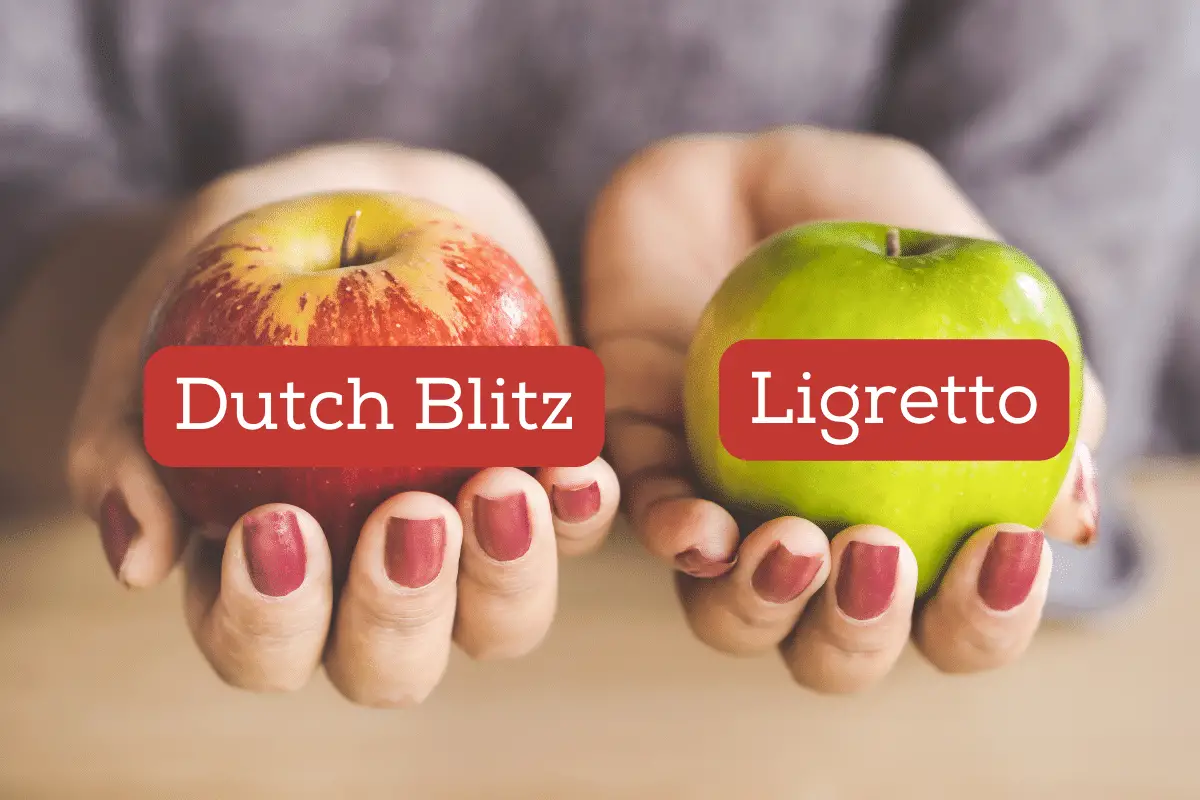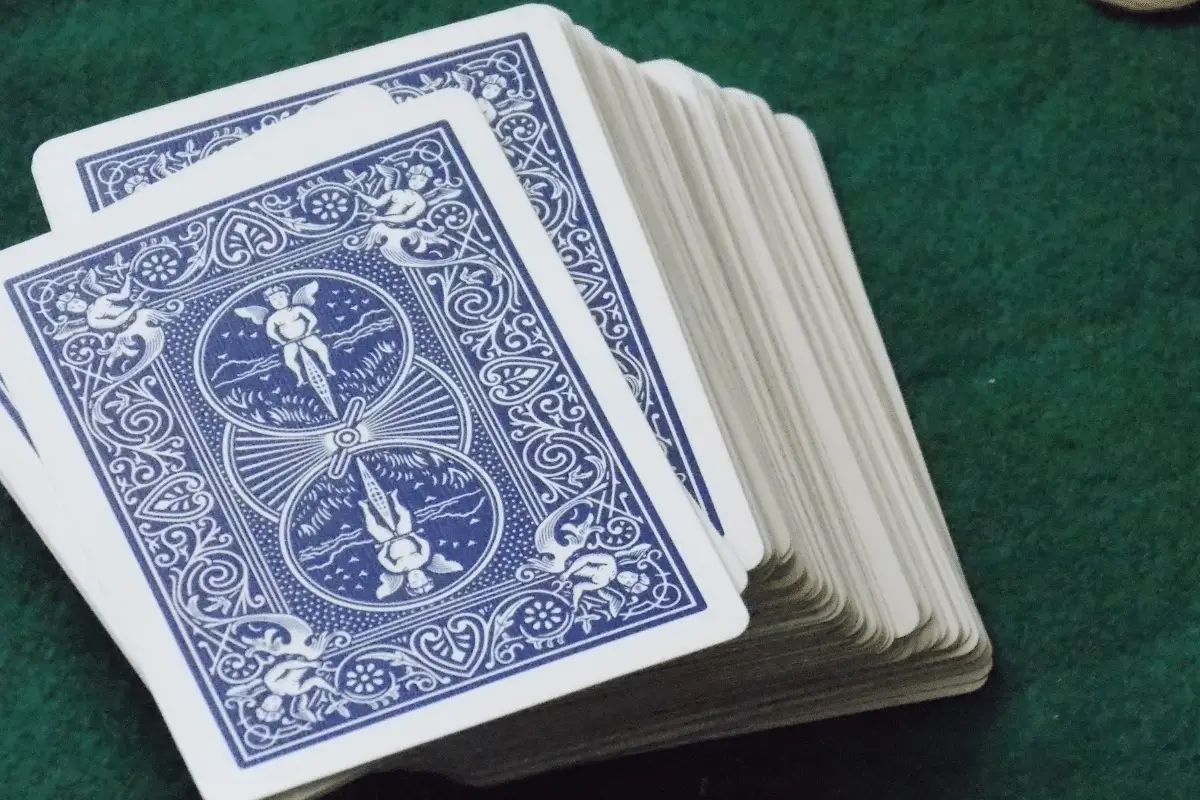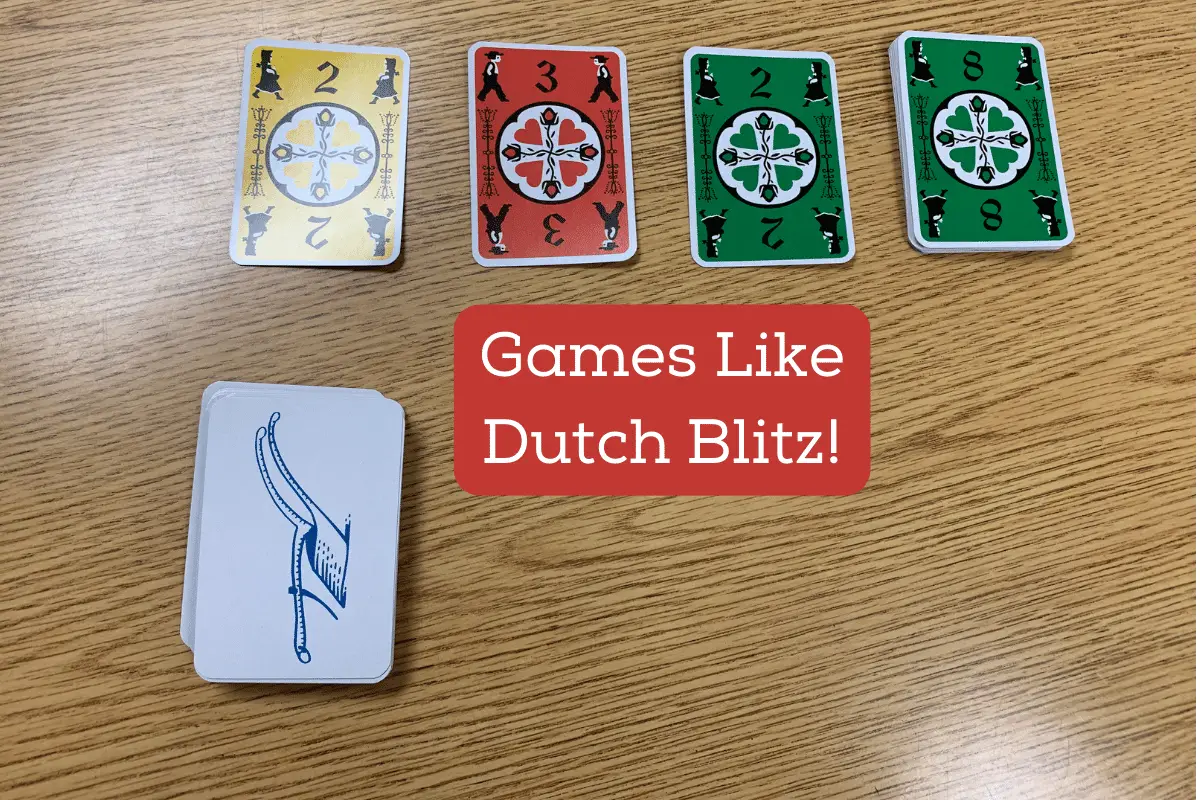I’ll still teach people Dutch Blitz all of the time and hear them compare it to the game of Ligretto.
It’s not quite as common a comparison because my area hasn’t played a lot of Ligretto.
But when I looked into it, the similarities were shocking!
For those who want to know how they compare and if you should get one or the other, this Dutch Blitz vs. Ligretto comparison is for you.
Dutch Blitz and Ligretto are essentially the same game. They’re so similar; there’s no real point in getting them both unless you just want something new to look at. The main differences are in the style of cards and the terms used for the different piles.
If you want more details beyond this, read on!

If you don’t know how to play Dutch Blitz, check out our complete guide for everything you need to know A to Z.
Table of Contents
Dutch Blitz And Ligretto Differences And Similarities
It’ll be easier to look at the differences between these two card games because outside of these minor differences, they are exactly the same.
Both are based on the same core gameplay as games like Nerts or Pounce or Racing Demon, but these two are essentially the same variant, marketed and designed in different ways.
Style Of Cards
The makeup of the packs is exactly the same:
- 4 decks
- Each deck with its own back
- 40 cards
- 4 different colors
- Number 1-10
It’s the design and back of the cards where the two games differ.
While Dutch Blitz plays into the Pennsylvania Dutch aspect of the game using pictures like Pail, Plow, Pump, and Carriage, Ligretto instead opts for bright colors and geometric designs.
It’s a colorful and eye-catching way of looking at the cards.
Terms For The Piles
These games use all the same amount of piles with the same purposes, but the terms for each of these piles are different based on the game.
This chart does a good job of explaining the similarities.
| Dutch Blitz | Ligretto | Purpose |
|---|---|---|
| Blitz Pile | Ligretto Stack | 10 cards in front of the player; play this to end the round and stick the other players with negative points |
| Post Piles | Row | 3 piles/spots to move Blitz/Ligretto cards to in order to help them get out faster |
| Wood Pile | Hand | Leftover cards to help play; must be flipped over three at a time |
| Dutch Piles | Piles | Piles in the middle anyone may play on; must go from 1-10 in order matching color |
| “Blitz!” | “Ligretto, stop!” | What you yell when you’re out of cards in your Blitz/Ligretto pile |
The rules for the games change slightly based on if there are two players.
Look at how to play Dutch Blitz for 2 players.
Stacking On The Row/Post Piles
One minor difference (depending on the version you play) is stacking in the Post or Row piles.
Dutch Blitz allows you to stack cards on top of other Post Piles if the cards go in descending order and alternate Boy-Girl.
According to the base game of Ligretto, stacking isn’t allowed on the Row.
As a result, Ligretto tends to get “stuck” more often, meaning no one can play anything from their Ligretto, Row, or Hand.
When this happens, players stop play, shuffle their Hand, and then restart from where they are.
There is an “advanced rule” to Ligretto that allows you to stack on the Row.
Like Dutch Blitz, you need to stack in descending order, and you may not match color from one card to the other.
Points To Win
As another minor difference, each game plays to a different point amount.
The first player to get to 75 points in Dutch Blitz wins.
But the player who wants to win in Ligretto needs to go to 99 points.
Scoring remains the same between the two games.
At the end of each round (when someone empties out their Blitz or Ligretto pile), scoring happens in three steps:
- Any cards left in the Blitz/Ligretto piles count as -2 per card.
- Cards played in the middle (Dutch or Piles) are worth +1 each.
- Combine these two with any previous point total for a current score.
Should I Get Dutch Blitz Or Ligretto?
Both games play almost the same; you should get the one you prefer the style for.
In general, Dutch Blitz costs less, so I’d suggest it first, but if you love the look of Ligretto’s bright colors and geometric shapes, there’s not much of a difference in price at the end of the day.
Check out both options here on Amazon at the links below:
Commonly Asked Questions
What Does Ligretto Mean In English?
Ligretto has no meaning in any language; it’s simply the name of the game.
The earliest form of this game came from Germany in the 1960s, a few decades after Dutch Blitz and Nerts were popular.
In 1988, the game settled into its current form and was published by Rosegarten Spiele and designed by Michael Michaels.
Starting in 2009, it’s been marketed more across the pond in North America.
Ligretto fans say Dutch Blitz came first, and Dutch Blitz fans say it was the other way around.
Since both are based on earlier games, the point is largely moot.
Do The Amish Play Dutch Blitz?
The Dutch referred to by the game aren’t people from the Netherlands but the Pennsylvania Dutch.
This includes people from the Mennonite and Amish communities.
Its popularity in these communities is hard to gauge, but it’s safe to say it’s played often enough that most people in these communities have at least heard of the game (in the same way, we Michiganders all know how to play Euchre).
How Many Dutch Piles Can You Have In Dutch Blitz?
There is no limit to how many Dutch Piles you can have in the middle of your Dutch Blitz game. As long as the pile starts with a 1 and goes in ascending order matching colors, it’s possible to have 4 piles per player all going at the same time.
The same is true of Ligretto. Piles aren’t limited; it’s purely based on what is available as you play the game.
Games with larger numbers of players will have more piles in the center.








